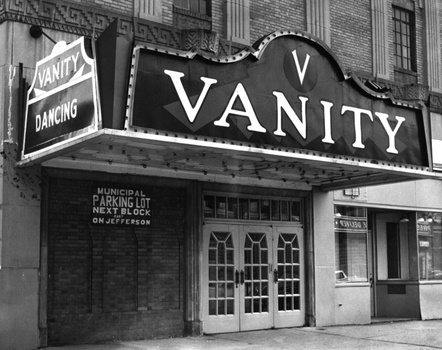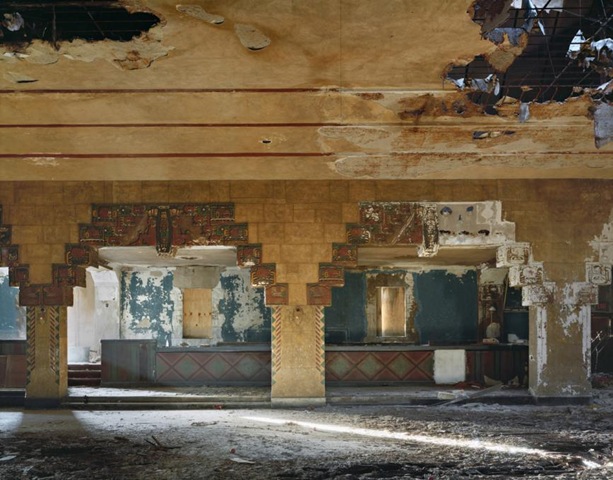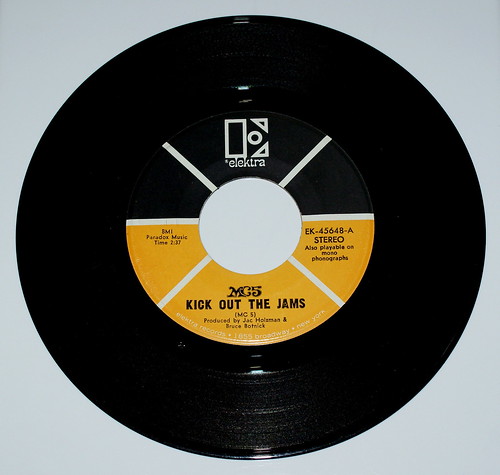This cache is NOT at posted-coordinates.
DO NOT go INSIDE the building looking for this cache.
The puzzle is designed to give you some history about a very
important part of Detroit's Entertainment past...and hopefully future.
You must sign the log to claim the find. Thank you!
This cache is a "sister" cache to:
GC45WAW - Come Dancing: The Grande Ballroom
"...Come dancing
Come on, sister
Have yourself a ball
Don't be afraid
To come dancing
It's only natural
Come dancing
Just like the palais on a Saturday
And all her friends will come dancing
Where the big band used to play..."
- Excerpt from the lyrics to "Come Dancing"
by the Kinks (US release 1983)
The Vanity Ballroom
Open: 1929 - Closed: 1988

The Vanity had shops on the first floor, and dancing on the second. 1929 photo
In the 1920s, six extraordinary ballrooms were built in Detroit--the Graystone, the Grande, the Jefferson Beach, the Mirror, the Monticello and the Vanity. Patrons went to these spectacular ballrooms to socialize, dance, listen to various performers and bands over the many years that these ballrooms were open.
There was an ongoing contest between architects to create flashy and innovative ballrooms for the public to enjoy. Aztec and Totec motifs were often used which made patrons feel that they were entering a fantasy world within these well-designed and fantastic venues. The Vanity Ballroom on Newport St at Jefferson Avenue was given these characteristics by Detroit architect Charles N. Agree who is now well-known for some of his other architectural wonders in and around Detroit. The Vanity was considered by some to be like a "Mayan Temple" on the city’s east side. The Vanity Ballroom billed itself as "Detroit's most beautiful dance rendezvous."

Polished and spacious floors awaited and welcomed dancers to the Vanity Ballroom (unknown date)
In designing the Vanity, Charles N. Agree worked an Aztec theme into the Art Deco style. The ballroom is filled with stepped archways, rich earth-toned colors and Aztec symbols which were all inspired by pre-Columbian archaeological discoveries of the time. Stylized Indian heads, stepped- brick archways and green-glazed tiles hovered over the dancers’ heads and the outside of the building is faced with orange brick with stone and tile ornamentation. Everything from the light fixtures to the curtain behind the stage had a Mayan-inspired theme to it. The stage curtain featured a scene of Chichen Itza temples.
The Vanity was built by Edward J. Strata who would manage the ballroom for 30-plus years. He and his partner Edward J. Davis had built the Grande Ballroom across town on the West Side of Detroit in 1927 (it opened in 1928) and the two locations, including the land, materials, and contents, cost about $500,000 in 1920's dollars. This would be equivalent to about $6.2 million in 2013 dollar value.

The sign that once hung on the Jefferson side of the building.
The Vanity is, for all intents and purposes, the sister-ballroom of the Grande. The Vanity catered to the city’s east side and eastern suburbs whereas the Grande lured those on the west side of Metro Detroit. Both were designed by Agree, and, like the Grande, the Vanity’s ballroom is on the second floor, above street level.
Below the dance floor are five commercial retail spaces which at one time held a Cunningham’s drug store, Friedberger’s jewelry store, a Harry Suffrin clothing shop, Burns Shoes and later other familiar retail names of their era.

Artists concept drawing of the Vanity
Inside the Vanity, there were two long bars, a very large cloak room, and of course a soda fountain for patrons to get a refreshment or two. Alcohol was not permitted when the Vanity opened as this was the time of prohibition, but the sodas and juices could be purchased for ten-cents each. There was a set of 15-inch speakers suspended from the ceiling, along with a bandstand and a revolving chandelier with light- reflecting mirrors.

Concept drawing for the interior Ball Room
The Vanity Ballroom's opening-night was on the eve of the stock market crash in 1929 on Detroit’s far east side at Newport and Jefferson. It would be the the last of the great dance venues to open because of the Great Depression. Despite this, the Vanity was one of the most popular dance venues in town and a place generations of Detroiters would go to hear live performances by Duke Ellington, The "King of Swing" Benny Goodman, Louis Prima, Jimmy and Tommy Dorsey, Cab Calloway, the Woody Herman Orchestra, Tony Pastor and Claude Thornhill. In later years, folks would enjoy rockers like the MC5 and the Stooges, as well as a few other acts of the Rock-n-Roll era.

1930 view of the main Entrance on Newport
In its heyday, the Vanity hosted huge crowds upwards of 1,000 couples or more. Five nights a week, they would dance to the big bands on the 5,600-square-foot maple dance floor, where couples “floated” on springs that were beneath the floor and gave the floor some "bounce". The 1930s was the time of the Great Depression and admission to the Vanity was only 35 cents. From the entrance on Newport, folks would ascend a grand main staircase before being whisked into a different era. In the case of the Vanity, it seemed to be an "ancient Aztec temple", but in Modern Times.

One of the bars in the Vanity. 2008
During the 1930s and early ‘40s, the Vanity Ballroom would hold 'theme nights' as a way to keep things interesting. On Sundays, up to 900 couples would jam the floor and dance to whomever was playing that night.
Some patrons would visit several of the area Ballrooms in any given week... all for an evening of dancing and drinking sodas and having fun. Many folks wouldn't date anyone that didn't know how to dance.

1990 photo of the Vanity entrance on Newport.
As time went on, the cost of musicians and entertainment began to increase and the era of Big Bands began to decline. During the mid-1950's, a new form of entertainment began to invade the American home. Television started holding the attention of the American public and also Rock & Roll came to give folks young and old alike something else to do. Rock & Roll was in...ballroom dancing was on its way out. With these entertainment and economic changes, as well as the tastes of the young people at the time, it was becoming increasingly harder to financially support places like the Vanity due to the decline of business.
Edward J. Strata passed-away in the mid 1950's and and the legal guardian for Strata's Widow attempted to manage and run the Vanity for a few years after that. He'd attended many a dance at the Vanity years prior, but did not have much success with it as a business. Because of this, in 1958 the decision was made to close the Vanity for the first time due to many of these factors.

2010: Close-up of the Aztec architecture on the outside of the crumbling building.
It would only be closed for a few short years until 1964 when the City of Detroit Parks and Recreation Department opened it up and would start holding dances as part of the Mayor's Departmental Council on Aging initiative.
In addition to the occasional dance, the Vanity mainly housed church and civic club events and the reception by the public to this was modest, considering what the Vanity was designed and built-for back in the 1920's. The city had hoped for and planned for an attendance of 250 dancers or more, and yet barely half that would show up at any given time.
The mid-1960's were a time of turmoil in the City of Detroit with racial tensions and social disruptions. The decline of Detroit in the post-1967 riots era took a toll on many business that fled to the suburbs. Many of the storefront shops disappeared and would not return because of how things had deteriorated over the years.

The Stage at the Vanity: 1973 (Top) - 2010 (Bottom)
In 1971 the building was sold to a small group of investors that breathed some new life into the Vanity. The Vanity became a venue for a host of Detroit musical acts such as the MC5, The Stooges, Ted Nugent & the Amboy Dukes.
 MC5, Charlie Auringer, at the Vanity 1971
MC5, Charlie Auringer, at the Vanity 1971

The Stooges, MC5, and others in a Concert flyer from 1971
The Grande Ballroom on Grand River and Joy had declining attendance and profits and the decision to close it came in 1972. Both the Vanity and the Grande Ballrooms could not survive on "Garage Rock" acts alone and the downturn of the areas they were in. The Grande's final show was on New Years Eve 1972 but the Vanity continued on.
 MC5's 'Kick out the Jams' vinyl 45
MC5's 'Kick out the Jams' vinyl 45
1975 brought a resurgence to dancing with the general public with the Disco Era in full-swing. Many of the dancers that had attended the Vanity before came back to relive some of their youth and dance beneath the red and blue lights that lit-up the Vanity's maple wood dance floor.

The dance floor at the Vanity Ballroom was still hopping in December 1975.
The Vanity offered occasional dances, along with the area YMCA and other venues. While this was good, the crowds paled in comparison to the ballroom's glory days of the 1930's and 40's. The decline in the surrounding neighborhood didn't help matters either. People began to move away and there was some minor incidents, but enough that security had to be hired and escort patrons to and from their vehicles. This put a damper on a resurgence of business for the dance hall.

Close-up of a ceiling light-fixture (recent)
In 1980, twin brothers Ronald and Donald Murphy bought the Vanity from the investment group because of a love of history and classic architecture. The twins were tour guides at Greenfield Village, a museum in nearby Dearborn, and wanted to do what they could to try to help "glue Detroit back together" and did what they could to try to save the aging building, even though the City had plans to demolish the Vanity.
The Murphy brothers located Charles Agree (the original Architect) who was 82 years old at the time and living in Southfield, MI. They consulted with him on restoration efforts for the Vanity and attempted to restore it to its former magnificent glory. They verified that what they had remaining at the Vanity was the same as what the architect had and were able to move-forward with restoration plans for the Vanity based on Agree's information and photos.

1970's view of the Vanity from the west.
They'd planned for various jazz and disco-themed parties and even some ballroom dancing. There was a planned fall of 1980 opening for a storefront Jazz museum, as well as other storefront occupants to return. The brothers began restoring the Vanity with fresh paint, repaired and updated electrical and sound systems, and even connected a 1936 Wurlitzer Jukebox into the overhead speakers. They touted it as being "one of the hottest spots in the city" in a newspaper article in 1980.

1980's color picture
It was to be the city's last great Rock venue, having outlived the Eastown and Riviera Theatres, Grande Ballroom, Michigan Palace, and a few other small venues. One of the biggest challenges was it's location, far away from downtown Detroit. It was also fighting the decline and decay of the neighborhood in which it sat. Along with this, the Vanity was not able to get a liquor license which the brothers felt would be necessary to attract patrons to the venue.

A Concert Flyer from May 23, 1981
The Vanity did reopen in 1983 to a few small crowds, but only for about a year before it closed again. It remained closed until late 1986 when it would reopen again as a Caribbean-style entertainment venue. The ballroom became the home base for Hugh Borde’s Trinidad Tripoli Streel Band on Friday nights. A promoter said he had hoped to branch out into big band music, progressive rock and jazz. On Dec. 12, 1987, a birthday party was held at the Vanity for the MC5’s former frontman, Rob Tyner. But the venue continued to struggle as the Jefferson-Chalmers neighborhood did and soon closed it's doors for the last time shortly after that.

Close-up of the aztec decor inside the Vanity (recent)
On November 12, 1982, while it was still open, the Vanity was listed on the National Register of Historic Places. This was done as a testament to the Vanity's architectural and cultural importance and to try to preserve what remains of this historic building. Unfortunately, it was not considered to be of any importance by the State of Michigan even with the National Registry designation.

Pictured here at center, Benny Goodman prior to a show in 1982
Later on, when filming for the 2002 film "8 mile" was being planned, the Vanity was included as part of the fliming locations. It ended up having a small-part in a major movie-production that was filmed here in Detroit. "Jimmy", the character that Eminem plays, is driving along East Jefferson when his car stalls-out. Where his car finally comes to rest he is right at the corner of East Jefferson and Newport, next to what's left of the old Vanity Ballroom. This was a nice surprise to many of the movie-goers that recognized the Vanity having this "bit-part" in the film. Even with this little bit of stardom, it remains closed and dilapidated.

The main ballroom floor, 2012
In May 2008, 26 years after the National Historic Registry was added, the Vanity was included on a list of 10 "endangered buildings" in Detroit. The roof has long-since been damaged by time and neglect, as well as looters and scrappers taking anything of value from what once was a Mayan-style Palace of a grand scale. Much like the temples of ancient civilizations, the Vanity is quickly becoming a modern-day ruin and will be nothing more than a memory if nothing else is done to preserve it.

2010 exterior view of the Vanity
What remains today in 2013, is a place of great architecture and historical significance and is very much intact, even though missing a lot of it's original decor and paint. It remains the last intact ballroom of Detroit, having it's glory days of the big band era in the 1930's and 1940's and later the Rock-n-Roll of the early 70's still resounding within these Aztec walls. The original marquee was removed as a safety-precaution in the 1990's, but the Vanity could see life again given someone with the vision, and finances, to make such a reality happen for this historical place with such a rich and storied musical past.
 A flyer from the Vanity's better days, laying around on the dance floor in 2009
A flyer from the Vanity's better days, laying around on the dance floor in 2009
The Puzzle: N 42° AB.CDE W 082° ZY.XWV
A: Second digit of the day there was a birthday party for Rob Tyner.
B: Second digit of the age of Charles Agree at the time the Murphy Brothers contacted him about the Vanity.
C: Fourth digit of the year The Kinks released the single "Come Dancing" in the US.
DE: The Brothers installed a 19_DE_ Wurlitzer Jukebox in the Vanity and connected it to the overhead speakers
Z: Second digit of the size of the speakers that were suspended from the ceiling.
Y: The third digit of the year of the riots that began an era of decline for the city of Detroit.
X: The third digit of the year the group 'Velvet Underground' was scheduled to play at the Vanity
W: The fourth digit of the year the decision was made to close the Vanity for the first time.
V: During the time of the Great Depression, admission to the Vanity was only _V_5 cents.
To validate your solution, you may check your work below:
